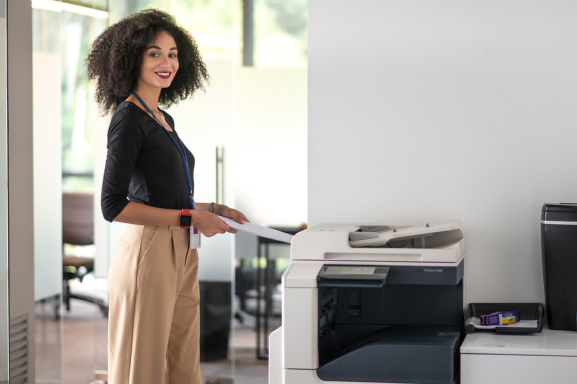Multifunction Printer Buying Tips: What to Consider for Best Results
Choosing a printer can seem like a daunting task. But if you need to combine a printer with a few more functions, things can get even more stressful. Technology is consistently geared toward combining functions for convenience, and the multifunction printer is a prime example of this convergence.
But which multifunction printer is the right one for you? That’s something best answered by you, and we’re here to help. The key is asking the right questions and knowing your printing needs, your environment, and your budget. Let us help you narrow down your options and help you make the best-informed decision you can. A printer is a big investment, after all.
What Makes a Multifunction Printer Tick?
Most modern multifunction printers come with the ability to print, scan, and copy your files. While earlier versions would include faxing features, this has become increasingly obsolete in the current market. A big part of choosing your printer is asking: which functions are most important to me, and how well do I need them to work? Let’s take a look at some important features and factors of different multifunction printers.
Inkjet vs. Laser Printing
All modern printers are divided into these two categories. Which you choose will ultimately come down to price, quantity, and quality of printing you need.
Inkjet printers tend to be found in smaller multifunction printers, particularly those designed for home and small business use. They have a reputation for reliability, longevity, and comparative cost efficiency.
Inkjet printers use cartridges to apply ink directly to the page via a mobile printhead. This head usually has a long lifespan and will save you on maintenance in the long run. You may remember the inkjet printers from the past operating slowly, but recent versions have increased in printing speed. They’re not as fast as laser printers, but they’re much closer than they were.
Inkjet cartridges are separated by – black, cyan, magenta, and yellow. Basic inkjet printers will have the colored tones combined into one cartridge, while more advanced ones will have separate cartridges for each. This separation leads to a much better image quality than a laser printer. Unfortunately, the inkjet does need all colors to function. If one has run out, you won’t be able to print until you buy a refill.
Laser printers are usually larger multifunction printers and are known for printing high volumes at high speed.
Color laser printers are a more recent development than their inkjet counterparts, and most can’t match the image quality that ink can produce. Finding ones that can replicate the color quality will be very expensive.
These printers use a rolling drum and static electricity to apply powdered toner to paper. These drums need to be replaced relatively often, so your maintenance costs will be higher. The printers themselves will also cost you more. However, when factoring in higher output, speed, quality, and extra functionality, these machines will more than make up for that cost over time.
The Scanner
The scanner is key to getting good image quality. Higher-end multifunction printers will offer you more scanning options and a higher resolution, measured in dots per inch (dpi). If you’re looking for exceptional image quality (for printing photos, for instance), look for a higher dpi scanner.
Another factor to consider is scanning speed. While many inkjet printers will allow you to scan one page at a time, larger laser printers have trays that let you insert multi-page documents at once and scan them in a matter of seconds, albeit at lower resolutions.
The quality and speed of your scanner will also impact the copying ability of your printer. You’ll also need to decide how fast or detailed you need those copies.
Speed
A small printer offers about 10-20 pages per minute (ppm). These are usually inkjet printer speeds. Larger laser printers can average speeds of about 40-60 ppm. Printers at Stargel Office Solutions can match and exceed the fastest laser printers on the market.
Page Pricing
When looking at a list of printer specs, you may come across “ppp.” This stands for price per page. This takes several factors into account, like ink, power, maintenance, and the cost of the paper itself. When printing in higher volumes, laser printers will be the winners here. A printer that can print duplex (print double-sided) will also lower this cost.
Connection
Some printers are wireless, enabling any network device (including some smartphones) to connect to them. Smaller printers are often cable-bound to a local area network (LAN) or one PC.
Fancier multifunction printers also offer the opportunity to send scanned documents to email accounts. These printers will usually come with wireless capabilities, too.
Duty Cycles
This is how many pages a printer can print in a month before running into mechanical errors such as smudging and jamming. Inkjet printers can’t handle the same workload as laser printers. They’ll average 1,000 pages a month while a laser printer can manage 15,000.
Efficiency
If you want to save money and the environment, then energy efficiency should definitely be a factor. Some printers come with specialized software to help minimize power usage. You can often find this information on the manufacturer’s website.
Which Multifunction Printer Is Right for You?
Now you know more about the features of a multifunction printer, you need to narrow down your choices. Here are some questions to ask:
What Am I Using It for?
Are you printing photos or tons of PDFs? If image fidelity and copying quality are important, then you’re better off buying a higher-end inkjet printer. If quantity and speed are important, then go laser.
Monochrome or Color?
Inkjet printers will usually do a better job with higher-quality color images. Black and white printing will always save you money, no matter the printer type.
How Much Am I Printing?
Smaller monthly outputs are best suited to smaller inkjet printers. Most laser printers only start saving you money at higher outputs.
What Am I Willing to Spend on Upkeep?
Multifunction printers work hard and need more care as a result. They also need their toner drums replaced more often than the heads of an inkjet printer. Is your output worth the extra expense?
Where Am I Using This?
Are you looking to buy for your home, a small office, or a larger company? Not only is size a consideration but also the output of your printer.
Don’t Be Daunted
It can be quite stressful choosing a printer, but it doesn’t have to stay that way. As long as you know what you’re looking for, and ask the right questions you’ll be able to narrow things down quite a bit.
And if you need some expert advice and experience, why not use ours? We have over 30 years of experience in providing the best office solutions for Houston because we’re always looking to go above and beyond our customer’s expectations. Why not contact us today, and let’s help you find the best multifunction printer to take you forward?



